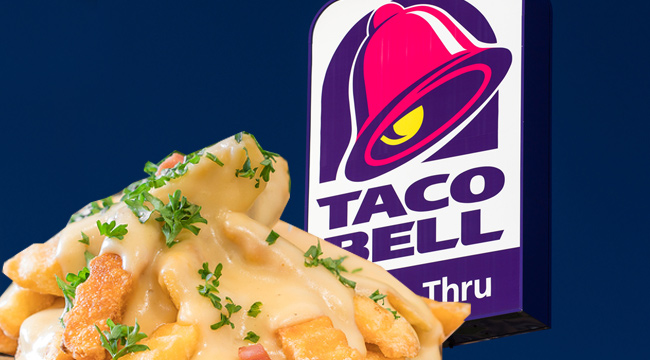
Things looked bad for awhile there for Taco Bell. In the 2000s, as the country came to understand Mexican food better and culinary exploration grew increasingly popular, moving away from eating Taco Bell became a sort of right of passage. Then, in 2006, an E.Coli outbreak that sickened more than 70 people hit the company hard. Later, there was a Samonella scare. The rise of Chipotle didn’t help matters either. Add in the fact that there’s a direct corollary between unemployment numbers in the 18-34 demographic and Taco Bell sales, and it’s easy to see why the end of the 2000s were tough.
Then the other shoe dropped: a lawsuit accusing Taco Bell of using 65% fillers in their meat. 90 days later, the suit was quietly withdrawn, but the fallout was severe and resulted in a 2% drop in sales.
Things were looking bleak. Until some yahoo decided to turn a Dorito into a Taco Shell back in 2012. It was the brand’s biggest launch ever and came with a huge media blitz (the president of the brand even did an AMA). The product was a major success and kickstarted a new era in the fast food wars. Brands started testing products left and right, experimenting constantly, and catering to social media audiences. Taco Bell tried massive crunchwraps and fried chicken shells. Some of these launches became permanent menu items, others were stunts, meant to remind the public, “We’re still here!” Some definitely didn’t work, others did.
The brand paired these offerings with clever marketing plays, like the “Steal A Game, Steal A Taco” promotion, and a savvy social media team:
Today on #Snapchat Menu Hacks, learn how to recreate the #BaconClubChalupa + 3 more throwback items using our app. https://t.co/FiFYlFZLSx pic.twitter.com/w04SJdTtFD
— Taco Bell (@tacobell) December 14, 2016
Never change, Ryan. https://t.co/JdE7i8yd6R
— Taco Bell (@tacobell) January 3, 2017
At the same time, Taco Bell started developing a parallel track: Healthy food. They took out the queso and added pico. They made their menu easy to customize. Last year, Business Insider announced “Taco Bell has subtly become one of the healthiest fast-food chains” (an idea we put to the test).
The result: Sales have trended upward since 2013. Which brings us to today and Taco Bell’s “New Year’s Commitments. The idea behind these fits with Taco Bell’s stated commitment to transparency (and incredible media savvy, since many of these ideas have already made a splash online).
A few highlights:
Taco Bell is saying goodbye to its XL soda cups.
By early 2017, the brand will remove all antibiotics important to human medicine from its chicken.
Where possible, Taco Bell is removing preservatives and other additives from its food by 2018.
Taco Bell reached its goal to serve only 100% cage-free whole eggs on its breakfast menu. Now, the brand is expanding its commitment to serve 100% cage-free egg ingredients across the core menu. That means the eggs used to create its avocado ranch sauce, creamy jalapeno sauce, habanero sauce and creamy chipotle sauce will be made with cage-free egg ingredients come January 1, 2018.
Taco Bell reduced sodium by 15% on average across its menu since 2008, but isn’t stopping there. By 2025, Taco Bell will grow that number by an additional 10%, for a 25% reduction across its menu, while still delivering the same bold flavors fans love.
There’s also a promise to keep the $1 menu and leave the “craveable, cheesy, often-indulgent” items in place — basically a code for, “WE SEE YOU, STONED, BROKE 20 YEAR OLD WITH A GREAT METABOLISM. WE’RE NOT LEAVING YOU!” And though there is no specific talk of more launches, you can bank on it. With loaded fries, chicken nachos, and the “burrito taco” all rolling out in the past few weeks, it looks like the brand will continue its habit of launching items quickly and letting the public react.
Menu moves aside, the push for healthier, more sustainable food is sure to pull in an older demographic and capture some of Chipotle’s customers — an interesting twist in the fast food war saga.






